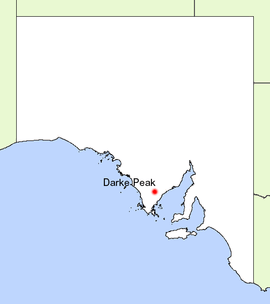Darke Peak
| Darke Peak South Australia | |
|---|---|
 Location of Darke Peak in South Australia | |
| Population | 175 (2006 census)[1] |
| Established | 1914 |
| Postcode(s) | 5633 |
| Elevation | 247 m (810 ft) |
| Location |
|
| LGA(s) | District Council of Cleve |
| State electorate(s) | Flinders |
| Federal Division(s) | Grey |
Darke Peak (formerly Carappee) is a small agricultural town located in central Eyre Peninsula, South Australia. The town is the population centre for the surrounding agricultural district and has become a minor historical tourist town. The J. C. Darke Memorial and Grave, commemorating early European explorer John Charles Darke, is located near the township and is located on the South Australian Heritage Register.[2]
The town has a number of limited facilities, including accommodation, grocery and fuel supplies. At the 2006 census, Darke Peak had a population of 175.[1]
History
The town takes its name from the explorer John Charles Darke, who was injured in a spear attack by Aborigines in the vicinity of the peak on 24 October 1844. He died the next day and was buried at the foot of the large peak.[3] Governor Grey expressed a wish that some landform in the region of the grave should be named to honour him. In 1865 surveyor Thomas Evans who was performing a trigonometrical survey of the Gawler Ranges and named the 1,564 ft (477 m) high mount, 'Darke's Peak'.[4]
In 1909, another surveyor, W.G. Evans, reported that he had found bones in a grave and was satisfied they were the remains of Darke. Darke's grave and monument are located on the western side of the range, still standing as a memorial to the first European who explored this area. The memorial was erected by the SA Government in 1910.[3]
The township of Darke Peak was originally proclaimed Carappee in 1914. The town was renamed in 1940 after the peak that bears John Charles Darke's name as further honour to the explorer. A school opened in the town in 1917.[5]
Darke Peak includes Darke Range, Caralue Bluff, Carappee Conservation Park and Carappee Hill in the surrounding area, with Carappee Hill known for being the highest exposed granite rock mass on Eyre Peninsula.[6]
Economy
Darke Peak is predominantly a farming community, with surrounding areas producing cereal crops, with sheep also produced as a backup for when the region experiences poor rainfall. Local farmers have been farming the area for a number of generations, predating the establishment of the town. The farming areas are very similar to other towns across the central Eyre Peninsula, growing much the same crops under similar climate conditions.[7]
Tourism is a minor component of the towns economy, with Darke's Grave, The Darke Range and various tourist drives the main attractions. Tourist information is present at The Peak Stop shelter.
Facilities
Darke Peak has a hotel which dates back to the early days of the settlement and offers accommodation and meals.
Sporting facilities in the town include tennis and netball courts, oval, playground, swimming pool and a golf course, with some sports teams competing in local leagues.[7]
Government
The township of Darke Peak is encompassed in the District Council of Cleve, the State Electoral district of Flinders and the Federal Division of Grey. The town is under the mayorship of Allan Edwards.
References
- 1 2 Australian Bureau of Statistics (25 October 2007). "Darke Peak (State Suburb)". 2006 Census QuickStats. Retrieved 30 July 2011.
- ↑ "JC Darke Memorial & Grave". South Australian Heritage Register. Department of Environment, Water and Natural Resources. Retrieved 13 February 2016.
- 1 2 State Library of South Australia Manning Index, Darke Peak, retrieved 2007-06-13
- ↑ District Council of Cleve, Darke Peak History, retrieved 2007-06-13
- ↑ "NEW TOWN NAMES APPROVED". Chronicle. LXXXIII, (4,728). South Australia. 1 August 1940. p. 13. Retrieved 31 August 2016 – via National Library of Australia.
- ↑ District Council of Cleve, Darke Peak Recreation, retrieved 2007-06-13
- 1 2 Tourism Eyre Peninsula, Darke Peak, retrieved 2007-06-13
External links
Coordinates: 33°28′S 136°12′E / 33.467°S 136.200°E